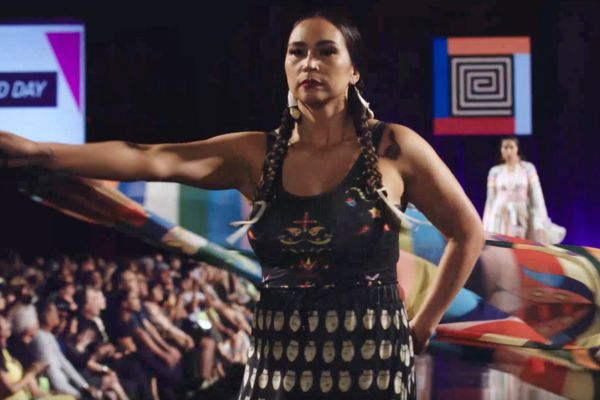
- Details
- By Darren Thompson
SANTA FE—This week, the organization that hosts the Santa Fe Indian Market announced it is expanding its marquee Southwestern Association for Indian Art (SWAIA) program into a stand-alone fashion event.
“Santa Fe Native Fashion Week by SWAIA Indigenous Fashion” will debut next spring in a four-day fashion event, May 2-5, 2024.
The four-day event will feature a fashion symposia, a soirée, and runways that feature Indigenous fashion professionals from the United States and Canada.
“Santa Fe Indian Market has always been about showcasing and making sure our artists have that same voice and that includes fashion,” said SWAIA Executive Director Jamie Schulze in an interview with Native News Online. “That is a really important voice to me because that’s representation and that’s something our cultures have struggled with and have been invisible for so many years.”
“It is important for us to come out as the creatives that we have always been historically, not only through our jewelry, our sculpture, and these amazing art pieces, but what we wore,” said Schulze who is Northern Cheyenne and Sisseton Wahpeton Oyate.
“It takes an entity like SWAIA to take the lead in creating an overdue runway that will now showcase and celebrate the first Designers of these lands, the Indigenous people,” said Norma Baker-Flying Horse, a Grammy Award-winning fashion designer from the Fort Berthold Indian Reservation in North Dakota, to Native News Online.
Since SWAIA launched its Indigenous Fashion Show in 2014, its shows have grown, from attendance of 150 to 9 separate fashion events planned at this year’s market weekend. It is now a highlight of the largest American Indian arts festival in the world, attracting dedicated Indigenous fashion designers from the United States and Canada.
The organization is responding to growing success amongst Indigenous fashion designers, models, makeup artists, and producers.
Jen Atchico, an enrolled Kickapoo Tribe of Oklahoma citizen and makeup artist living in the Seattle area, says that the announcement of SWAIA’s Santa Fe Native Fashion Week is huge for Native professionals in the industry. “I’m super excited for SWAIA’s Native Fashion Week,” she said in a comment to Native News Online.
Cora Kay Chandler, a fashion show producer from the Fort Belknap Indian Community and producer of the National Center for American Indian Enterprise Development’s (NCAIED) Reservation Economic Summit’s fashion show, said she heard of SWAIA’s announcement online.
“I am very glad for the artists that they are promoting as well as the up-and-coming ones,” Chandler told Native News Online. “It would be great to invite emerging artists because a lot of times we focus on mainstream artists that are definitely well known.”
Kelly Holmes, founder and editor of Native Max Magazine, said SWAIA’s announcement is good news for many in the industry. A long time fashion show producer, Holmes told Native News Online, “we need more events like this because they empower our growing Nation fashion community and market.”
SWAIA launched a website in conjunction with its announcement at swaianativefashion.org as well as an Instagram page @swaianativefashion. More information will be announced at this year’s Santa Fe Indian Market, August 19-20, 2023 in Santa Fe, New Mexico.
More Stories Like This
Chickasaw Holiday Art Market Returns to Sulphur on Dec. 6Center for Native Futures Hosts Third Mound Summit on Contemporary Native Arts
Filmmakers Defend ‘You’re No Indian’ After Demand to Halt Screenings
A Native American Heritage Month Playlist You Can Listen to All Year Long
11 Native Actors You Should Know
Help us defend tribal sovereignty.
At Native News Online, our mission is rooted in telling the stories that strengthen sovereignty and uplift Indigenous voices — not just at year’s end, but every single day.
Because of your generosity last year, we were able to keep our reporters on the ground in tribal communities, at national gatherings and in the halls of Congress — covering the issues that matter most to Indian Country: sovereignty, culture, education, health and economic opportunity.
That support sustained us through a tough year in 2025. Now, as we look to the year ahead, we need your help right now to ensure warrior journalism remains strong — reporting that defends tribal sovereignty, amplifies Native truth, and holds power accountable.
 The stakes couldn't be higher. Your support keeps Native voices heard, Native stories told and Native sovereignty defended.
The stakes couldn't be higher. Your support keeps Native voices heard, Native stories told and Native sovereignty defended.
Stand with Warrior Journalism today.
Levi Rickert (Potawatomi), Editor & Publisher

